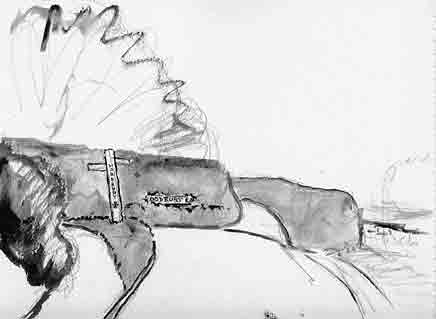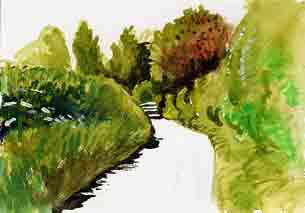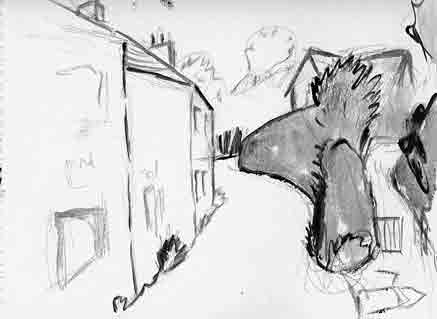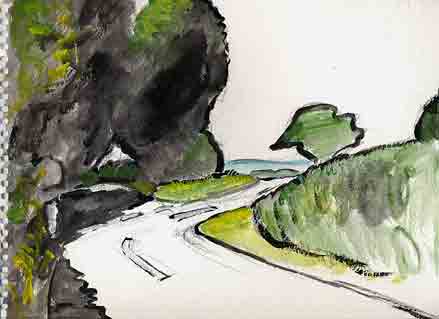The Lyme Maze Game

This is Woodbury Lane, but its beginning seems merely the axis of a small suburb of Axminster's. Of this lower end of the lane, a resident from an earlier time told me: "It used to be so narrow you could hardly get through, between the allotments on one side and the orchards on the other." The vegetable allotments survive in the valley to the left, but the orchards have become the yards of houses. The lane turns to the right, climbing steeply out of the stream valley, and throwing off a few suburban culs-de-sac, but soon it comes to a sharper corner, called, according to the legend on the signpost, Woodbury Cross.
The lane straight ahead, Wyke Lane, is a dead end that would take you past Higher Jackleigh Farm and Great Jackleigh Farm and Higher Wyke Farm and Wyke Farm to a hamlet called Wyke Green, where it ends. It is this little district that is torn across by the modern A35 highway, separating the farms and passing over the lane on a bridge. I discovered, after wondering about it several times, that the lane actually offers, by connecting to some intricate paths, a way up to Trinity Hill and thus the only route from Axminster to Lyme without setting foot or wheel on the busy A 35; but I'm not going to recommend it. Woodbury Lane itself turns to the left and becomes a true country lane, deep in vegetation and quiet. The traffic you're likeliest to meet is a walker from the suburb with her dog.
(This was a glance backward as I paused to pump the tire of my bicycle.) The lane passes Woodbury Farm and rambles uphill for a mile, mostly open. In one place where it penetrates a knot of trees, there is a cluster of gateways leading to hidden mansions called Chattan House, Middle Chattan, Chattan Court, Chattan Hall Cottage—definitely not local names; this seems to be an outlying colony of the Clan Chattan from the Scottish Highlands. A bank on the left shows that, though the mower drove his machine by not long ago, he spared the bluebells that survived into May. PICTURE: bluebells spared ] Farther on, a low section of the hedge on the left gives a view down over a quintessential farm in the valley—Old Park Farm.
Then comes the Woodbury village hall. Once as I pedalled past here, three or four carloads of people arrived and went into the hall; they told me they came every Thursday to play short-mat bowling. Another time, a caretaker emerged from the hall, and told me he was Woodbury's longest resident, having lived here "forty-seven or forty-eight years". Among the scraps I picked up from him: The building of the A 35 bypass road higher up the slope set off a mighty mudslide, which sent a telegraph pole "walking" down the hill, and caused a certain kink in the lane. And Roman pottery turned up in one of the fields, so there is an order on it that it can't be ploughed; another can be mown only in September, to leave it half wild. The short steeper bit from the village hall up to the church is where you cross, geologically, from the Lower Lias to the Upper Greensand formation of the Cretaceous period. You may be able to notice the changed colour in the banks. Tiny Woodbury church looks ancient, but was built only a hundred years ago as a chapel for Old Park House behind it. It is one of the small churches now administered by a "team", in other words the Axminster vicar goes around on Sunday to here, Musbury, ==. You might expect five people to struggle here on Sundays, but when we decided to go there at Easter we found standing-room only. Afterwards one of the congregation told us how a working party of twenty-seven volunteers got the refurbishing of the interior done in a fortnight, at a cost of six hundred pounds. "The plaster had to be of the old kind, modern plaster doesn't work on old structures . . . Axminster Carpets virtually donated the aisle carpet, charged four hundred pounds, which was just about the cost of the hems . . . " Winding on past the church, the lane comes to the hamlet: a tight little group consisting of three joined cottages on the left and a larger house set back a bit on the right.
Arriving around the curve of the cottages you find that the lane makes an acute turn back to the left, while on the right is nothing but a secluded driveway. Yet this point was once a lively crossroads. The driveway and the leftward lane preserve the line of the old thoroughfare from Lyme to Axminster, now eclipsed by the layout of modern highways nearby. The taller house on the right (or, actually, its predecessor, burned down in 1920) was the toll house. As the mail coach came rattling down the road from Lyme, the driver blew a horn, and the toll-gate keeper, who lived on the upper floor, had to rush downstairs and open the gate. If he didn't get it open in time, causing the coach to stop, he was fined. (What if the coach merely had to slow?) The lane that you've come along, and that here crosses the old Lyme-Axminster road at a narrow angle, may be even older: it may follow the line of the Roman road. Woodbury was nearer than Axminster itself to the point where the Roman road crossed the Fosse Way and then crossed the river Axe, and there was a Roman fort at Woodbury—I haven't yet learned exactly where. On the other side of the Axe, the straight line of the Roman road (in line with this one through Woodbury) is evident in the A 35 and then the lane that departs from it through Kilmington. I've had several good conversations with Woodbury people as I idled through the tiny place, and one of them told me: "You should talk with Mr. Furzey, he's the oldest one who's lived here, his mother was the cook at Old Park House, he lives in Axminster now", so I'm hoping to find him. The segment of lane ahead, which must have gone at an acute angle off what is now the private driveway, and which was called Cook's Lane, has disappeared entirely, under the embankment of one of the new roads. So you have to double back around the corner to the left, past the garden gates of the cottages whose faces you passed on Woodbury Lane. (And a little farther along, in what looks like a stretch of unkempt hedge, you have to be moving slowly to notice a hole that proves to be another tiny gate so overgrown that now a child would have to crawl through it; and another; each gives a glimpse of sunshine past the smothering leaves; do they lead to the same garden?) This segment ends very soon. Ahead is the stub of the old road from Axminster, now blocked off. The newer version of the road diverges, and up to the right is the way onto it.
The stub of road is a dozen yards long, forming a shady harbour under the trees. But in front of it is posted what I strongly suspect of being an anti-Gypsy notice: "No Parking or Overnight Camping". Why the hell not? One of the residents explained to me: "Well, it would block the entrance to that house." There is on the left a gateway to a drive, but it's only half way along the stub of road. Turn to the right out of Woodbury; there's no way but into the traffic for a while. |




